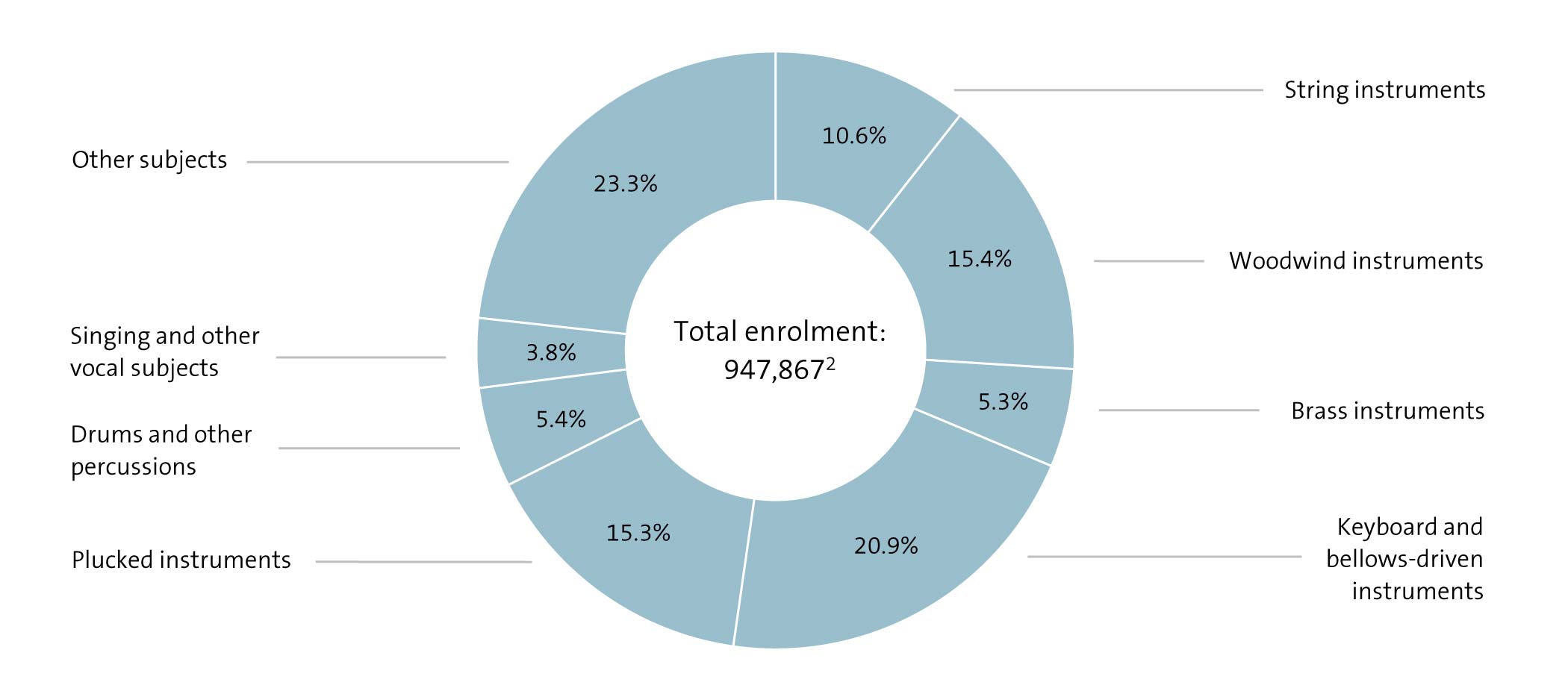About 950,000 pupils were recently enrolled in the instrumental and vocal subjects offered by the public music schools in the VdM. The data also include other forms of teaching such as instrument merry-go-rounds, classroom music-making and elementary music classes (ensemble and supplementary subjects are not taken into account). Approximately 21 % of the subject enrolments were for keyboard and bellows-driven instruments, about 15 % each for woodwind and plucked instruments and about 11 % for string instruments. Approximately 220,000 children and teenagers took part in other forms of instruction (ca. 23 %). The data of the VdM statistics 2021 refer to the entire calendar year 2020 and thus reflect the situation in the first year marked by the COVID‑19 pandemic. Overall, the public music schools recorded about 58,000 fewer subject enrolments in 2020 than in the previous year.

The most frequently taught instruments at public music schools are piano (with around 163,000 pupils enrolled) and guitar (almost 123,000). Violin (slightly more than 67,000), percussion and other percussion instruments (more than 51,000, including almost 22,000 in drumset, Germany's ‘Instrument of the Year’ 2022) and flute (around 36,500) are also very popular. The trend for recorder lessons is clearly declining, but with about 51,500 pupils, the recorder was still the fourth most frequently chosen instrument.
In the subjects with lower numbers of pupils, different trends could be observed in the years before the beginning of the pandemic. In a comparison of the VdM statistics 2020 and 2014 (reference year is in each case the previous calendar year), there were increases of more than 20 % in the subjects viola, double bass, tenor horn and especially in harp and other plucked instruments. On the other hand, the number of pupils in the subjects keyboard and electric organ (-21 %) and electric guitar (-37 %) decreased by around 6,000 in each case.
All instrumental and vocal subjects recently recorded declining enrolment figures as a result of the COVID‑19 pandemic. This is particularly evident for woodwind instruments (7,927 fewer pupils than in the pre-pandemic year) and plucked instruments (-6,842). The decline in other subjects (group offers such as instrument merry-go-rounds, classroom music-making, elementary music classes, band classes) is even more serious: Compared to the preceding calendar year, about 30,000 fewer children and teenagers were reached by these offers in 2020. It is especially the younger children who could not take advantage of group offers under the corona protection measures and for whom digital alternatives are not yet effective due to their age.

Note
The data is based on an annual full survey of the Association of German Music Schools (VdM) among its member schools; most recently these were 933 public music schools. This chart shows the number of students in instrumental and vocal subjects (without ensemble or supplementary subjects). Figures up to and including the year 2013 are taken from 1 January of the year concerned; those after 2014 are based on a full calendar year (1 January to 31 December of the preceding year). This change of methodology has a significant impact on the number of students, for the later figures also include pupils enrolled in projects or other courses of limited duration as well as those who dropped out during the year and were thus previously excluded from statistics based on the 1 January reference day.
Footnotes
-
The impact of the COVID-19 pandemic is captured for the first time in the VdM annual report 2021: The data reflect number of student enrolments of the previous calendar year 2020, cf. note.
-
The total number of students differs from that given in statistic ‘Age distribution at public music schools in the Association of German Music Schools (VdM)’, since the present chart excludes pupils enrolled in ensemble and supplementary courses.
-
As of 2014, a new methodology of data collection has been applied. See note.
-
Number of VdM member music schools on 1 January of the subsequent year.
-
As of 2015, including baritone horn.
-
As of 2010, including voice training.
Source information
Compiled and calculated by the German Music Information Centre from VdM-Jahresbericht 2021, ed. Association of German Music Schools (VdM), 2022, and various issues of Statistisches Jahrbuch der Musikschulen in Deutschland, published annually by the VdM.






